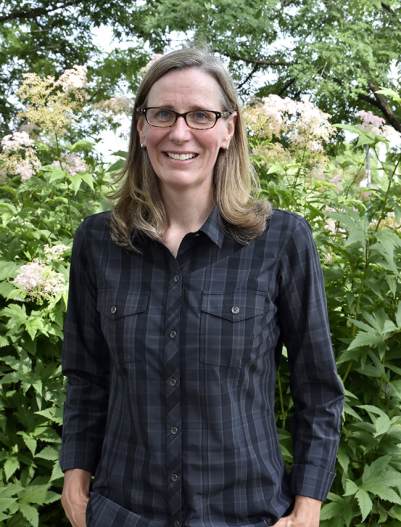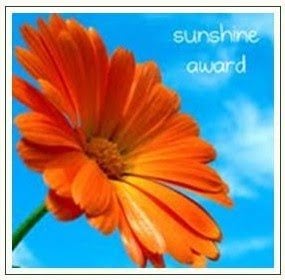Gardening for Native Bees: Interview with Heather Holm
A couple of months ago I heard Heather Holm speak on gardening for native bees at a forum organized by the Lurie Garden. Heather is an award-winning author and widely-recognized advocate and educator for native bee conservation. Educated in Canada, she currently lives in Minnesota. She was nice enough to agree to respond to some written questions for this blog.

Why should native bee conservation be an urgent concern for gardeners?
With the significant amount of habitat loss, we can no longer just garden for ourselves. We have native bees, in particular bumble bees, threatened with extinction or endangered.
How much of a difference can home landscapes make regarding this problem?
Home landscapes can play a significant role in supporting native bee populations, especially if there is a community-based effort of many people gardening or providing flowering plants in a connected corridor in a neighborhood. Native bees are limited in their flight distance and do much of their foraging in a small area if an adequate supply of food is available. They are also adept at finding new sources of food such as the new garden someone just installed. If you plant it, they will come.

In a nutshell, how can gardeners help native bees?
Provide a variety of flowering plants that bloom continuously throughout the growing season, eliminate pesticide use, and provide and protect nesting opportunities for bees.
How do you see the relationship between conservation of native bee species and honeybees?
Apples and oranges. Much is known about the honey bee and the population changes of the honey bee which can be attributed to their domestication (pathogens and disease) and environmental risks such as pesticides. Many people are not aware that the honey bee is a stable species and not at risk of extinction. The media has put too much focus on this one species drawing the public’s attention away from native bees, the bees in need of conservation. Very little is known about population changes of native bees, however, with the exception being bumble bees. One can likely conclude that habitat loss, exposure to pesticides, and climate change are factors also impacting these understudied species.

What is the relative importance of perennials, small trees and shrubs, and shade trees when it comes to native bee conservation?
They are all important. Woody plants including trees and shrubs can play a significant role in providing forage for native bees. Just think of the scale, size, and number of flowers a large insect-pollinated shade tree provides compared to a perennial garden. Creating and maintaining large perennial gardens may not be for everyone so I always encourage people to start with planting trees.
Why are native plants so important to the future of native bee species?
Native plants are particularly important for pollen-collecting specialists (oligolectic) bees which are dependent on, in many cases, collecting pollen from plants belonging to a single genus. Also, native bees have coevolved with a diversity of native plants which historically, would have provided all their nutritional needs.

Many exotic plants seem to be very popular with bees, native or otherwise. Do they have a role in bee conservation in home landscapes?
Yes, exotic plants can attract native and non-native bees. Plants in the mint family Lamiaceae, for example, can provide a good source of nectar for foraging bees and in particular male bees. It is important to remember that the most important dietary component in the food provided for bee larvae is pollen and many exotic plants that get a lot of visitation by native and non-native bees are not necessarily providing all of the critical nutritional components a bee would need. Exotic plants can complement a diverse native planting, helping to ensure a continuous, overlapping succession of flowering plants, or in other words, ensuring the restaurant is always open.
How can gardeners who like an abundant cottage garden style (which abhors bare ground) still make room for ground nesting bees?
I am in favor of covering the ground with filler plants and natural materials such as leaves instead of using wood mulch. It is often stated that native bees need bare ground but many ground nests are initiated under vegetation, not in open bare ground. Heavy layers of wood mulch applied year after year can impede a bee’s access to the ground. In my own garden, I transitioned from using wood mulch for weed suppression over ten years ago and instead let nature provide the natural, ground-covering materials (leaves and plant debris). These natural materials (and a dense herbaceous planting) help with weed suppression but still allow access for bees which crawl underneath the layer of leaves to access the soil. I have seen bees use the exposed soil from edging a lawn as a nesting site too.

What else can gardeners do to help provide nesting opportunities for native bees?
Look for existing ground nests in your garden particularly in the spring before your plants start to grow and cover the ground. If you have existing nests, it can provide you with a lot of information such as preferred soil and exposure. If you find nests, consider how you can provide similar opportunities. For above-ground nesting bees, the majority of which use preexisting cavities, I recommend leaving topped flower stalk stubble (15” tall) from the previous growing season. The other simple thing one can do is incorporate logs on the ground in the garden. Standing dead trees are also beneficial but often not practical for small gardens.
Tell us about your new book, Bees: An Identification and Native Plant Forage Guide. How is it helpful to gardeners?
My new book is a combination of a bee identification guide profiling 30 genera of bees, and a plant library including 100 native trees, shrubs, and perennials that support bees and other pollinating insects. It has a comprehensive listing of pollen-collecting specializations featuring many specialist bees and several of the plants specialist bees depend upon. There is extensive information on the cultural requirements for the plants profiled, as well as pollinator visitation information. Gardeners can use the book in two ways: learn what to plant to attract pollinators, and identify and learn about the biology of the bees that frequent their garden.
Give us a couple of reasons to feel optimistic about the future of native bees.
I am encouraged by the growing movement to garden for wildlife – gardening for ecosystem functionality rather than just beauty. For a butterfly enthusiast, planting milkweed for monarchs may have been the first introduction to floral-faunal connections, for a birdwatcher, perhaps it was purposefully selecting a native shrub which produced fruit that birds devoured in late summer. More people making these connections means we are slowly converting the 40 million acres of useless lawn in the United States into something purposeful and beneficial to bees, birds, and butterflies.





A wonderful interview/post: informative, succinct, and positive in tone. I learned some new things — always a good result.
Glad you liked it.
I do everything I can for native pollinators but ground nesting bees is not something I’m willing to work around. Two summers ago, I was working and mistakenly came too close and was bitten 24 times. I’m hoping to not experience that again.
Hi–Sorry you had that experience. Those were most likely German Yellow Jackets or possibly Bumblebees. It would be good to be able to know what critter it was that attacked you. The solitary nesting bees Heather is speaking of would not be physically able to do something like that. For one, their stingers are either not that strong or they are vestigial. Two, they are not social, which means they are only interested in provisioning for their nesting site and young.
I’m with Shoreacres: wonderfully informative, succinct, and upbeat. I learned quite a bit, and I am happy to report that even in my shady garden, there is a lot that bees of all kinds like.
Trees are not the usual plants that we look to when we talk about planting for pollinators. Planting trees as a first step for someone that is new to gardening is such a great idea.
Whether we realize it or not, we garden for the world not just for our selves. Gardening with knowledge and a purpose we can have even more impact. Thanks for this information. Also I believe most ground nesting bees, not wasps and hornets, are not aggressive and do not sting.
Fascinating and encouraging. Thank you. I’m going to buy her book now. Miss being able to go to Lurie events!
So you were in Chicago, as well as Sin City and Slaterville? Incidentally, I commented on your blog (nice), but I think it ended up in your spam file.
Interesting!
It is nice to read about native bees. I am fascinated by them.
There’s a lot to learn. I got her new book and I’m looking forward to reading it.
This is a nice interview! I heard Heather speak at the UW-Madison Arboretum’s Native Plant Conference a couple of years ago. Her message, her writing, and her presentations are inspiring.
I agree.
Great post! There are no shortage of bumble bees here on the farm and I haven’t noticed a decline in their population here. Honey bees seem to be in abundance at certain times while other times I don’t see that many.
Bumble bees and Carpenter Bees are usually plentiful here, though there are many species of Bumble Bees and I don’t know how many are represented.
Great post–informative and positive-which we all need. And I must agree that ‘if you plant them, they will come’. I’ve seen that in my own gardening experience.
Yes, I feel fortunate that it has also been our experience.
A wonderful, informative post. I did enjoy it.xxx
Glad to hear it!
Very interesting post, Australia has similar problems with native bees losing natural habitat, but also a growing awareness. 🌞
Seems there are similar problems all over the world.
Very interesting! I need to learn to notice and recognize ground nesting and other native bees.
Our garden/yard is (large and) rather natural and so far we have always had plenty of bumble bees, even when a decline is reported in many areas of our country (Finland).
It’s good that bees are plentiful, here I’ve noticed there has been a decline over the last ten years.
Great post to get the word out about our native bees. I have found Heather’s books very informative and use them regularly for plant selection and bee identification. My son is creating a native bee habitat and nesting boxes for his Scout Eagle project.
That’s a great idea!
This was a great post. Please keep up the good work!
Thank you for reading!
Excellent.